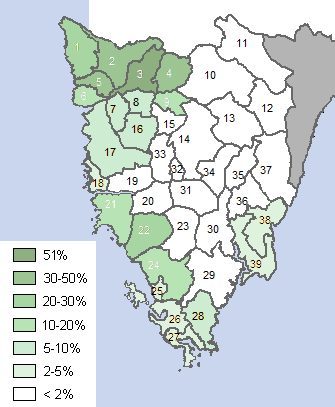|
TV Koper-Capodistria
TV Koper Capodistria is a Slovene free-to-air television channel based in Koper, Slovenia. Mainly funded by state aid, the channel serves the Italian-speaking minority in Slovenia and Croatia. It can also be received in the Italian region of Friuli-Venezia Giulia. Popular shows The channel covers international, regional, and local news from both sides of the border. The editorial section for culture programmes shows Artevisione, Istria e... dintorni, L’Universo e`... and Itinerari. The shows, with documentaries, reports, and magazine formats, focus on the regional and local cultural life in Slovenia, Italy, and Croatia. The channel is notable by the first music video TV show, not only in the former Titoist Yugoslavia, but also in the neighboring Italy, featuring popular Western music videos during the 1980s with its host Dario Diviacchi enjoining a star status among his young TV audience. The show, first under the name "Alta Pressione" ("High Pressure") and later "Video Mix ... [...More Info...] [...Related Items...] OR: [Wikipedia] [Google] [Baidu] |
1080i
1080i (also known as Full HD or BT.709) is a combination of frame resolution and scan type. 1080i is used in high-definition television (HDTV) and high-definition video. The number "1080" refers to the number of horizontal lines on the screen. The "i" is an abbreviation for "interlaced"; this indicates that only the even lines, then the odd lines of each frame (each image called a video field) are drawn alternately, so that only half the number of actual image frames are used to produce video. A related display resolution is 1080p, which also has 1080 lines of resolution; the "p" refers to progressive scan, which indicates that the lines of resolution for each frame are "drawn" on the screen in sequence. The term assumes a widescreen aspect ratio of 16:9 (a rectangular TV that is wider than it is tall), so the 1080 lines of vertical resolution implies 1920 columns of horizontal resolution, or 1920 pixels × 1080 lines. A 1920 pixels × 1080 lines screen has a total of 2.1 ... [...More Info...] [...Related Items...] OR: [Wikipedia] [Google] [Baidu] |
Titoism
Titoism is a political philosophy most closely associated with Josip Broz Tito during the Cold War. It is characterized by a broad Yugoslav identity, workers' self-management, a political separation from the Soviet Union, and leadership in the Non-Aligned Movement. Tito led the Communist Yugoslav Partisans during World War II in Yugoslavia. After the war, tensions arose between Yugoslavia and the Soviet Union. Although these issues diminished over time, Yugoslavia still remained relatively independent in thought and policy. Tito led Yugoslavia until his death in 1980. Today, the term "Titoism" is sometimes used to refer to Yugo-nostalgia, a longing for reestablishment or revival of Yugoslavism or Yugoslavia by the citizens of Yugoslavia's successor states. Tito-Stalin split When the rest of Eastern Europe became satellite states of the Soviet Union, Yugoslavia refused to accept the 1948 ''Resolution of the Cominform'' and the period from 1948 to 1955, known as the Inform ... [...More Info...] [...Related Items...] OR: [Wikipedia] [Google] [Baidu] |
Television Channels And Stations Established In 1971
Television, sometimes shortened to TV, is a telecommunication Media (communication), medium for transmitting moving images and sound. The term can refer to a television set, or the medium of Transmission (telecommunications), television transmission. Television is a mass medium for advertising, entertainment, news, and sports. Television became available in crude experimental forms in the late 1920s, but only after several years of further development was the new technology marketed to consumers. After World War II, an improved form of black-and-white television broadcasting became popular in the United Kingdom and the United States, and television sets became commonplace in homes, businesses, and institutions. During the 1950s, television was the primary medium for influencing public opinion.Diggs-Brown, Barbara (2011''Strategic Public Relations: Audience Focused Practice''p. 48 In the mid-1960s, color broadcasting was introduced in the U.S. and most other developed countri ... [...More Info...] [...Related Items...] OR: [Wikipedia] [Google] [Baidu] |
Television Channels In Slovenia
Television, sometimes shortened to TV, is a telecommunication medium for transmitting moving images and sound. The term can refer to a television set, or the medium of television transmission. Television is a mass medium for advertising, entertainment, news, and sports. Television became available in crude experimental forms in the late 1920s, but only after several years of further development was the new technology marketed to consumers. After World War II, an improved form of black-and-white television broadcasting became popular in the United Kingdom and the United States, and television sets became commonplace in homes, businesses, and institutions. During the 1950s, television was the primary medium for influencing public opinion.Diggs-Brown, Barbara (2011''Strategic Public Relations: Audience Focused Practice''p. 48 In the mid-1960s, color broadcasting was introduced in the U.S. and most other developed countries. The availability of various types of archival storag ... [...More Info...] [...Related Items...] OR: [Wikipedia] [Google] [Baidu] |
Istria
Istria ( ; Croatian language, Croatian and Slovene language, Slovene: ; ist, Eîstria; Istro-Romanian language, Istro-Romanian, Italian language, Italian and Venetian language, Venetian: ; formerly in Latin and in Ancient Greek) is the largest peninsula within the Adriatic Sea. The peninsula is located at the head of the Adriatic between the Gulf of Trieste and the Kvarner Gulf. It is shared by three countries: Croatia, Slovenia, and Italy.Marcel Cornis-Pope, John Neubauer''History of the literary cultures of East-Central Europe: junctures and disjunctures in the 19th And 20th Centuries'' John Benjamins Publishing Co. (2006), Alan John Day, Roger East, Richard Thomas''A political and economic dictionary of Eastern Europe'' Routledge, 1sr ed. (2002), Croatia encapsulates most of the Istrian peninsula with its Istria County. Geography The geographical features of Istria include the Učka/Monte Maggiore mountain range, which is the highest portion of the Ćićarija/Cicceria ... [...More Info...] [...Related Items...] OR: [Wikipedia] [Google] [Baidu] |
Slovenian Littoral
The Slovene Littoral ( sl, Primorska, ; it, Litorale; german: Küstenland) is one of the five traditional regions of Slovenia. Its name recalls the former Austrian Littoral (''Avstrijsko Primorje''), the Habsburg possessions on the upper Adriatic coast, of which the Slovene Littoral was part. Geography The region forms the westernmost part of Slovenia, bordering the intermunicipal union of Giuliana in the region of Friuli Venezia Giulia of Italy. It stretches from the Adriatic Sea in the south up to the Julian Alps in the north. The Slovene Littoral comprises two traditional provinces: Goriška and Slovene Istria. The Goriška region takes its name from the town of Gorizia () now in Italy; the neighbouring conurbation of Nova Gorica and Šempeter-Vrtojba today is the urban centre of the Slovene Littoral. Slovene Istria comprises the northern part of the Istria peninsula and provides, on the Slovene Riviera coastline with the ports of Koper, Izola, and Piran, the countr ... [...More Info...] [...Related Items...] OR: [Wikipedia] [Google] [Baidu] |
Italian Language In Croatia
The Italian language is an official minority language in Croatia, with many schools and public announcements published in both languages. Croatia's proximity and cultural connections to Italy have led to a relatively large presence of Italians in Croatia. Italians were recognized as a state minority in the Croatian Constitution in two sections: Istrian Italians and Dalmatian Italians. Although only 0.43% of the total population is Italian by citizenship, many more are ethnically Italian and a large percentage of Croatians speak Italian, in addition to Croatian. As of 2009, the Italian language is officially used in twenty cities and municipalities and ten other settlements in Croatia, according to the European Charter for Regional or Minority Languages. It is an officially recognized minority language in Istria County, where it is spoken by 6.83% of the population on the aggregate and closer to 50% of the population in certain subdivisions. Italian-speaking population The 2011 C ... [...More Info...] [...Related Items...] OR: [Wikipedia] [Google] [Baidu] |
Istrian Italians
Istrian Italians are an ethnic group from the Adriatic Sea, Adriatic region of Istria in modern northwestern Croatia and southwestern Slovenia. Istrian Italians descend from the original Latinized population of Roman Empire, Roman Istria#Early history, Histria, from the Venetian language, Venetian-speaking settlers who colonized the region during the time of the Republic of Venice, and from the local South Slavic peoples, South Slavic people who culturally assimilated. Today, as a result of the Istrian–Dalmatian exodus, the majority of Istrian Italians live outside of the Istrian peninsula; however, a significant Italian minority still lives in the Croatian County of Istria (5.01%) and in Slovenian Istria, where they are granted minority rights. According to the official Slovenian and Croatia censuses conducted in 2001 and 2002 respectively, they number around 22,000. The Istrian exodus, Istrian diaspora (including not only Italians), on the other hand, numbers between 230,000 ... [...More Info...] [...Related Items...] OR: [Wikipedia] [Google] [Baidu] |
Digital On-screen Graphic
A digital on-screen graphic, digitally originated graphic (DOG, bug, or network bug) is a watermark-like station logo that most television broadcasters overlay over a portion of the screen area of their programs to identify the channel. They are thus a form of permanent visual station identification, increasing brand recognition and asserting ownership of the video signal. The graphic identifies the source of programming, even if it has been time-shifted—that is, recorded to videotape, DVD, or a digital personal video recorder such as TiVo. Many of these technologies allow viewers to skip or omit traditional between-programming station identification; thus the use of a DOG enables the station or network to enforce brand identification even when standard commercials are skipped. DOG watermarking helps to reduce off-the-air copyright infringement—for example, the distribution of a current series' episodes on DVD: the watermarked content is easily differentiated from "offic ... [...More Info...] [...Related Items...] OR: [Wikipedia] [Google] [Baidu] |
RTV Slovenija
Radiotelevizija Slovenija ( en, Radio-Television of Slovenia) – usually abbreviated to RTV Slovenija (or simply RTV within Slovenia) – is Slovenia's national public broadcasting organization. Based in Ljubljana, it has regional broadcasting centres in Koper and Maribor and correspondents around Slovenia, Europe, and the world. RTV Slovenija's national radio services operate under the name , while the television division carries the name or . The names are sometimes Anglicized as ''Radio Slovenia'' and ''TV Slovenia'', respectively. There are three national and four regional radio services, which can all be heard online as well. RTV Slovenija also finances the RTV Slovenia Symphony Orchestra and the RTV Slovenia Big Band. The legal foundation for the institution is the Radiotelevizija Slovenija Act ( sl, Zakon o Radioteleviziji Slovenija). It is the only public nonprofit broadcasting organization in Slovenia to operate both radio and television stations. The law also requ ... [...More Info...] [...Related Items...] OR: [Wikipedia] [Google] [Baidu] |
Phone-in
In broadcasting, a phone-in or call-in is a programme format in which viewers or listeners are invited to air their live comments by telephone, usually in respect of a specific topic selected for discussion on the day of the broadcast. On radio (especially talk radio), it is common for an entire programme to be dedicated to a phone-in session. On television, phone-in's are often part of a wider discussion programme: a current example in the UK is the "Jeremy Vine" TV show. The concept dates to the early radio era: a December 1924 BBC 5NG Nottingham phone-in programme is described in a 1925 Radio Times article: "listeners ... enjoyed the novelty of hearing their own voices taking part". A prior attempted phone-in to a BBC 2LO London programme "led to such a rush on the telephones that the Post Office had to intervene". Speech based Talk Radio UK was launched in 1995, with much of its programming featuring phone-ins. It also introduced the notion of the shock jock to the UK, with ... [...More Info...] [...Related Items...] OR: [Wikipedia] [Google] [Baidu] |
Music Video
A music video is a video of variable duration, that integrates a music song or a music album with imagery that is produced for promotion (marketing), promotional or musical artistic purposes. Modern music videos are primarily made and used as a music marketing device intended to promote the sale of Music Recording, music recordings. Although the origins of music videos date back to musical short, musical short films that first appeared, they again came into prominence when Paramount Global's MTV based its format around the medium. These kinds of videos were described by various terms including "illustrated song", "filmed insert", "promotional (promo) film", "promotional clip", "promotional video", "song video", "song clip", "film clip" or simply "video". Music videos use a wide range of styles and contemporary video-making techniques, including animation, live action, live-action, documentary film, documentary, and non-narrative approaches such as Non-narrative film, abstract fi ... [...More Info...] [...Related Items...] OR: [Wikipedia] [Google] [Baidu] |






.jpg)